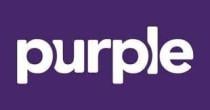increase in overall performance metrics
The Client
Purple is a digitally native brand with a mission to help people feel and live better through innovative comfort solutions. The company designs and manufactures a variety of innovative, premium, branded comfort products, including mattresses, pillows, cushions, frames, sheets, and more. Its products are the result of over 25 years of innovation and investment in proprietary and patented comfort technologies and the development of its own manufacturing processes.
The Situation
Purple wanted to bring a best-in-class user experience to life while making life at Purple a bit easier. Using tools such as Craft, WordPress, and Shopify, Purple struggled with content authoring versus maintaining central product information. Similarly, content edits required developers to make even the most minor updates to keep up with promotions and pricing.
Ultimately, generating online sales through a highly tuned user experience was the most important goal. The company’s e-commerce site is a primary channel for the business and essential for Purple’s continued growth. Customers needed to easily explore products and enjoy a pain-free checkout experience, while at the same time, marketers needed minute control over promotions, pricing, and presentation.
The Challenge
Purple offers a wide range of mattress and accessory products; their differences can be hard to distinguish immediately. Purple’s design system focused on clean elements that emphasized product attributes with clear visuals, important callouts, and helpful comparison tools to help customers decide which was right for them.
The challenge, however, was that bringing to life a simple front-end experience for customers is often the result of a complex set of tools working together under the hood. To achieve this, Purple needed to sync pricing data from commercetools and layer in conditional pricing and promotions and custom display options — a complex feat to orchestrate but necessary to deliver better, more relevant customer experiences. In addition, the site’s performance had to be lightning-fast on any device. In e-commerce, especially with sites that leverage dense media assets, any drop in performance results in lost revenue.
The Solution
Purple’s in-house team created its design system but needed help adapting it to Drupal. Purple partnered with enterprise Drupal web development agency Elevated Third, which advised on the best way to “Drupalize” each component, developing them in an easily configurable way without bloat or technical debt. For example, what seems like simple product cards are actually a collection of custom image rendering options, dynamic pricing information displayed on the fly, third-party rating metrics, and contextual conditional indicators, such as “on sale” tags.
Imagery is a priority for most of Purple’s product and marketing pages, so properly handling media was critical for end-users and admins alike. Integrating Bynder as a digital asset manager into Drupal’s media library was the first step in making Purple’s media easy to manage. Custom cropping tools allow admins to specify focal areas for individual aspect images. Finally, images are rendered in WebP format via vanilla-lazyload for a speedy front-end experience.
Another site feature where user experience and admin management come together is the site’s mega menus. Large menus like Purple’s have long since evolved past single-column lists of static links to be more visually engaging but rarely do these have good tools for non-developers to edit them. Elevated Third designed a system to leverage Layout Builder for menus, allowing admins to move components around and edit the visual hierarchy.
Performance and uptime are critical for Purple to support its e-commerce revenue stream, so caching and performance tools were essential – the best design, UX, and checkout flow in the world is worth little when the site is slow. Acquia Cloud Platform provides the advantage of streamlined deployment tools and environments predictably tuned for Drupal performance and Acquia’s monitoring tools helped Purple stay on top of performance issues during and after deployment.
Underneath the Drupal theme layer is an integration with commercetools that powers Purple’s pricing and checkout process. Product pages ingest some product data via JSON and interact with the API driving product pricing. Once a user begins to interact with product options, that part of the page experience is handled by DMI’s React application that sits inside the Drupal page and delivers a user to the checkout process once they hit “add to cart.” This powerful integration ensured canonical pricing managed in commercetools is always displayed consistently across the site in areas outside the React app.
Last, and perhaps most critically, the new functionality supports Purple’s need to create, stage, and deploy timed content releases across the site. The company often needs to manage back-to-back promotions that must go live at precise times. Traditional content workflows would be too slow and cumbersome to manage this at scale, but Acquia makes it easy.
The Results
Purple saw a 15% increase in overall performance metrics following the launch. The promotions process has also improved significantly – with the implementation of Drupal with commercetools, promotions have run more frequently and faster. The complexity of promotions has always been prevalent based on the multiple types of offers, so having an organized, streamlined system has allowed Purple to become more flexible and nimble with the number of promotions and offerings it launches.
Additionally, development time has notably decreased. Before the project launch, it would take nearly four weeks from the development side to get promotions rolling. Now, Purple can easily make changes and tweaks in about three days in order to get a promotion launched. The combination of resources and time saved has resulted in a successful, improved brand perception for Purple, while also allowing the company’s dev teams to focus on creating a positive experience for customers and accounts rather than exhausting time on digital tools and new platforms.


